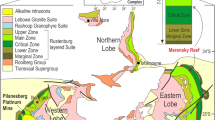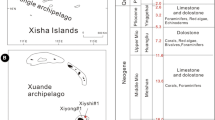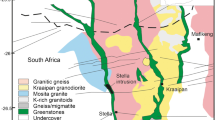Abstract
A petrogenetic model for the Merensky Reef in the Rustenburg section of the Bushveld Complex has been developed based on detailed field and petrographic observations and electron microprobe data. The model maintains that the reef formed by reaction of hydrous melt and a partially molten cumulate assemblage. The model is devised to account for several key observations: (1) Although the dominant rock type in the Rusterburg sections is pegmatoidal feldspathic pyroxenite, there is a continous range of reef lithology from pyroxenite to pegmatoidal harzburgite and dunite, and small amounts of olivine are present in nearly all pegmatoids. (2) The pegmatoid is usually bounded above and below by chromitite seams and the basal chromitite separated from underlying norite by a centimeter-thick layer of anorthosite. The thicknesses of the two layers exhibit a well-defined, positive correlation. (3) Inclusion of pyroxenite identical to the hanging wall and of leuconorite identical to the footwall are present in the pegmatoid. The leuconorite inclusions are surrounded by thin anorthosite and chromitite layers in the same sequence as that at the base of the reef. (4) Chromite in seams adjacent to plagioclase-rich rocks is characterized by higher Mg/Mg+Fe and Al/R3 and lower Cr/R3 than that in seams adjacent to pyroxene-rich rocks. Similar variations in mineral compositions are observed across individual chromitite seams where the underlying and overlying rock types differ. The chromite compositional variations cannot be rationalized in terms of either fractional crystallization or reequilibration with surrounding silicates. It is proposed that the present reef was originally a melt-rich horizon in norite immediately overlain by relatively crystallized pyroxenite. Magmatic vapor generated by crystallization of intercumulus melt migrated upward through fractures in the cumulate pile below the protoreef. The melt-rich protoreef became hydrated because fractures were unable to propagate through it and because the melt itself was water-undersaturated. Hydration of the intercumulus melt was accompanied by melting, and the hydration/melting front migrated downward into the footwall and upward into the hanging wall. In the footwall melting resulted first in the dissolution of orthopyroxene and then of plagioclase. With continued hydration chromite was stabilized as melt alumina content increased. The regular variations in chromite compositions reflect the original gradients in melt composition at the hydration front. The stratigraphic sequence downward through the base of the reef or pegmatoid (melt)-chromitite-anorthosite-norite represents the sequence of stable mineral assemblages across the hydration/melting front. The sequence is shown to be consistent with knowledge gained from experiments on melting of hydrous mafic systems at crustal pressures. With cooling the hydrated mixture from partial melting of norite footwall and more mafic hanging wall crystallized in the sequence chromite-olivine-pyroxene-plagioclase, with peritectic loss of some olivine. Calculations of mass balance indicate that a significant proportion of the melt was lost from the melt-rich horizon. Variations in the development of the pegmatoid and associated lithologies and amount of modal olivine in the pegmatoids along the strike of the Merensky Reef resulted because the processes of hydration, melting and melt loss operated to varying extents.
Similar content being viewed by others
References
Allan JF, Sack RO, Batiza R (1988) Cr-rich spinels as petrogenetic indicators: MORB-type lavas from the Lamont seamount chain, eastern Pacific. Am Mineral 73:741–753
Ballhaus CG (1988) Potholes of the Merensky Reef at Brakspruit Shaft, Rustenburg Platinum Mines: primary disturbance in the magmatic stratigraphy. Econ Geol 83:1140–1158
Ballhaus CG, Stumpfl EF (1985) Occurrence and petrologic significance of graphite in the Upper Critical Zone, western Bushveld Complex, South Africa. Earth Planet Sci Lett 74:58–68
Ballhaus CG, Stumpfl EF (1986) Sulfide and platinum mineralization in the Merensky Reef: evidence from hydrous silicates and fluid inclusions. Contrib Mineral Petrol 94:193–204
Barnes SJ (1986) The effect of trapped liquid crystallization on cumulus mineral compositions in layered intrusions. Contrib Mineral Petrol 93:524–531
Barnes SJ, Campbell IH (1988) Role of late magmatic fluids in Merensky-type platinum deposists: a discussion. Geology 16:488–491
Barnes SJ, Naldrett AJ (1985) Geochemistry of the J-M (Howland) Reef of the Stillwater Complex, Minneapolis adit area. I. Sulfide chemistry and sulfide-olivine equilibrium. Econ Geol 80:627–645
Boudreau AE (1986) The role of fluids in the petrogenesis of platinum-group element deposits in the Stillwater Complex, Montana. Unpubl PhD Dissertation, University of Washington
Boudreau AE (1988) Investigations of the Stillwater Complex. IV. The role of volatiles in the petrogenesis of the J-M reef, Minneapolis adit section. Can Mineral 26:193–208
Boudreau AE, Mathez EA, McCallum IS (1986) Halogen geochemistry of the Stillwater and Bushveld Complexes: evidence for transport of the platinum-group elements by Cl-rich fluids. J Petrol 27:967–986
Brynard HJ, De Villiers JPR, Viljoen EA (1976) A mineralogical investigation of the Merensky Reef at the Western Platinum Mine, near Marikana, South Africa. Econ Geol 71:1299–1307
Buntin TJ, Grandstaff DE, Ulmer GC, Gold DP (1985) A pilot study of geochemical and redox relationships between potholes and adjacent normal Merensky Reef of the Bushveld Complex. Econ Geol 80:975–987
Cameron EN, Desborough GA (1969) Occurrence and characteristies of chromite deposits — eastern Bushveld Complex. Econ Geol Monogr 4:23–40
Campbell IH (1986) A fluid dynamic model for the potholes of the Merensky Reef. Econ Geol 81:1118–1125
Campbell IH, Naldrett AJ, Barnes SJ (1983) A model for the origin of the platinum-rich sulfide deposits in the Bushveld and Stillwater Complexes. J Petrol 24:133–165
Cousins CA (1964) The platinum deposits of the Merensky Reef. In: Haughton SH (ed) The geology of some ore deposits of southern Africa. (Vol II) Geol Soc S Afr, Johannesburg, pp 225–237
Cousins CA (1969) The Merensky Reef of the Bushveld Igneous Complex. Econ Geol Monogr 4:239–251
Eales HV (1987) Upper Critical Zone chromitite layers at R.P.M. Union section mine, western Bushveld complex. In: Stowe CW (ed) Evolution of chromium ore fields. Van Nostrand Reinhold Co. New York, pp 144–168
Eales HV, Reynolds IM (1986) Cryptic variations within chromitites of the upper Critical Zone, northwest Bushveld Complex. Econ Geol 81:1056–1066
Elliott WC, Grandstaff DE, Ulmer GC, Buntin T, Gold DP (1982) An intrinsic oxygen fugacity study of platinum-carbon associations in layered intrusions. Econ Geol 77:1493–1510
Farquhar J (1986) The Western Platinum Mine. In: Anhaeusser CR, Maske S (eds) Mineral deposits of South Africa. Geol Soc S Afr. Johannesburg, pp 1135–1142
Fleet ME, MacRae ND (1988) Partition of Ni between olivine and sulfide: equilibria with sulfide-oxide liquids. Contrib Mineral Petrol 190:462–469
Fisk MR, Bence AE (1980) Experimental crystalization of chrome spinel in FAMOUS basalt 527-1-1. Earth Planet Sci Lett 48:111–123
Ford CE, Biggar GM, Humphries DJ, Wilson G, Dixon D, O'Hara MJ (1972) Role of water in the evolution of the lunar crust; an experimental study of sample 14310; an indication of lunar cale-alkaline volcanism. Proc Lunar Sci Conf 3rd: 207–229
Hamlyn PR, Keays RR (1979) Origin of chromite compositional variation in the Panton Sill, Western Australia. Contrib Mineral Petrol 69:75–82
Hatton CJ, von Gruenewaldt G (1985) Chromite from the Zwartkop Chrome Mine — an estimate of the effects of subsolidus reequilibration. Econ Geol 80:911–924
Helz RT (1976) Phase relations of basalts in their melting ranges at P H2O=5 kbar, part II. melt compositions. J Petrol 17:139–193
Henderson P (1975) Reaction trends shown by chrome-spinels of the Rhum layered intrusion. Geochim Cosmochim Acta 39:1035–1044
Henderson P, Suddaby P (1971) The nature and origin of the chrome-spinel of the Rhum layered intrusion. Contrib Mineral Petrol 33:21–31
Hill RL, Sack RO (1987) Thermodynamic properties of Fe-Mg titanomagnetite spinels. Can Mineral 25:443–464
Holloway JR, Burnham CW (1972) Melting relations of basalt with equilibrium water pressure less than total pressure. J Petrol 13:1–29
Irvine TN (1967) Chromian spinel as a petrogenetic indicator, part 2, petrologic applications. Can J Earth Sci 4:71–103
Irvine TN, Keith DW, Todd G (1983) The J-M platinum-palladium reef of the Stillwater Complex, Montana: II. origin by doublediffusive convective magma mixing and implications for the Bushveld Complex. Econ Geol 78:1287–1334
Jackson ED (1969) Chemical variation in coexisting chromite and olivine in chromitite zones of the Stillwater Complex. Econ Geol Monogr 4:41–75
Kinloch ED (1982) Regional trends in the platinum-group mineralogy of the Critical Zone of the Bushveld Complex, South Africa. Ecol Geol 77:1328–1347
Kinloch ED, Peyerl W (1990) Platinum-group minerals in various types of Merensky Reef: genetic implications. Econ Geol 85:537–555
Kruger FJ, Marsh JS (1982) Significance of 87Sr/86Sr ratios in the Merensky cyclic unit of the Bushveld Complex. Nature 298:53–55
Kruger FJ, Marsh JS (1985) The mineralogy, petrology, and origin of the Merensky cyclic unit in the western Bushveld Complex. Econ Geol 80:958–974
Kushiro I, Yoder HS Jr, Nishikawa M (1968) Effect of water on the melting of enstatite. Geol Soc Am Bull 79:1685–1692
Lauder WR (1970) Origin of the Merensky Reef. Nature 227:365–366
Leeb-du Troit A (1986) The Impala Platinum Mines. In: Anhaeusser CR, Maske S (eds) Mineral deposits of South Africa. Geol Soc S Afr, Johannesburg, pp 1091–1106
Mathez EA (1989) The nature of vapor associated with mafic magma and controls on its composition. In: Whitney JA, Naldrett AJ (eds) Ore deposition associated with magmas. Rev Econ Geol 4:21–31
Mathez EA, Dietrich VJ, Holloway JR, Boudreau AE (1989) Carbon distribution in the Stillwater Complex and evolution of vapor during crystallization of Stillwater and Bushveld magmas. J Petrol 30:153–173
McCallum IS (1968) Equilibrium relationships between the coexisting minerals in the Stillwater Complex, Montana. Unpubl PhD Dissertation, University of Chicago
McCallum IS, Raedeke LD, Mathez EA (1977) Stratigraphy and petrology of the Banded Zone of the Stillwater Complex, Montana (abstract). EOS 58:1245
Mostert AB, Hofmeyr PK, Potgieter GA (1982) The platinumgroup mineralogy of the Merensky Reef at the Impala Platinum mines, Bophuthatswana. Econ Geol 77:1385–1394
Naldrett AJ, Gasparini EC, Barnes SJ, von Gruenewaldt G, Sharpe MR (1986) The Upper Critical Zone of the Bushveld Complex and the origin of Merensky-type ores. Econ Geol 81:1105–1117
Nicholson DM (1989) The petrogenesis of the Merensky Reef, Bushveld Complex. Unpubl MS Thesis, University of Washington
O'Hara MJ (1968) The bearing of phase equilibria studies in synthetic and natural systems on the origin and evolution of basic and ultrabasic rocks. Earth-Sci Rev 4:69–133
Rutherford MJ, Sigurdsson H, Carey S, Davis A (1985) The May 18, 1980, eruption of Mount St. Helens, 1, melt composition and experimental phase equilibria. J Geophys Res 90:2929–2947
Sack RO (1982) Spinels as petrogenetic indicators: activity-composition relations at low pressures. Contrib Mineral Petrol 79:169–182
Sanford RF (1982) Growth of ultramafic reaction zones in greenschist to amphibolite facies metamorphism. Am J Sci 282:543–616
Schmidt ER (1952) The structure and composition of the Merensky Reef and associated rocks in the Rustenburg Platinum Mine. Trans Geol Soc S Afr 55:233–279
Sharpe MR (1985) Strontium isotope evidence for preserved density stratification in the main zone of the Bushveld Complex, South Africa. Nature 316:119–126
Stolper E (1977) Experimental petrology of eucritic meteorites. Geochim Cosmochim Acta 41:587–611
Vermaak CF (1976) The nickel pipes of Vlakfontein and vicinity, western Transvaal. Econ Geol 71:261–286
Viljoen MJ, Hieber R (1986) The Rustenburg Section of Rustenburg Platinum Mines Limited, with reference to the Merensky Reef. In: Anhaeusser CR, Maske S (eds) Mineral deposits of South Africa. Geol Soc S Afr, Johannesburg, pp 1107–1134
Viljoen MJ, De Klerk WJ, Coetzer PM, Nash NP, Kinloch E, Peyerl W (1986a) The Union Section of Rustenburg Platinum Mines Limited, with reference to the Merensky Reef; In: Anhaeusser CR, Maske S (eds) Mineral deposits of South Africa. Geol Soc S Afr, Johannesburg, pp 1061–1090
Viljoen MJ, Theron J, Underwood B, Walters BM, Weaver J, Peyerl W (1986b) The Amandelbult Section of Rustenburg Platinum Mines Limited, with reference to the Merensky Reef. In: Anhaeusser CR, Maske S (eds) Mineral deposits of South Africa. Geol Soc S Afr, Johannesburg, pp 1041–1060
Volfinger M, Robert J-L, Vielzeuf D, Neiva AMR (1985) Structural control of the chlorine content of OH-bearing silicates (micas and amphiboles). Geochim Cosmochim Acta 49:37–48
Walker D, Jurewicz S, Watson EB (1988) Adcumulus dunite growth in a small thermal gradient. Contrib Mineral Petrol 99:306–319
Author information
Authors and Affiliations
Rights and permissions
About this article
Cite this article
Nicholson, D.M., Mathez, E.A. Petrogenesis of the Merensky Reef in the Rustenburg section of the Bushveld Complex. Contr Mineral Petrol 107, 293–309 (1991). https://doi.org/10.1007/BF00325100
Received:
Accepted:
Issue Date:
DOI: https://doi.org/10.1007/BF00325100




